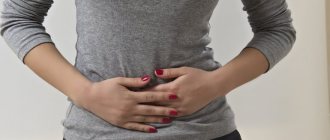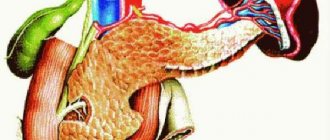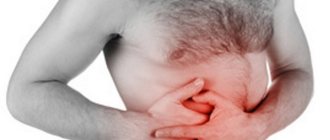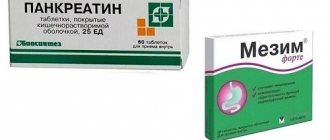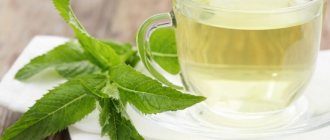In gastroenterology, one of the most popular drugs is Pancreatin.
Instructions for use are included in each package for consumer reference. Although the medicine is produced by many pharmaceutical companies in Russia and abroad, there are no significant differences in the composition. The drug is used to support the pancreas when the function of enzyme secretion is impaired. According to pharmacological classification, it belongs to the group of enzymes. Modern microgranular types with pancreatin (Creon, Micrasim, Ermital) are superior to the oldest medicine, but it still enjoys the trust of specialists and patients.
Official instructions from different companies create confusion in the minds of buyers, confusing the trade name of the drug “Pancreatin” with the main active component - a powder that is obtained from the pancreas of pigs and cattle (Pancreatin). When choosing the right remedy, you should pay attention to the possible inclusion of choleretic herbs, fiber, and intestinal enzymes in combination with it. Additional components are not useful for everyone.
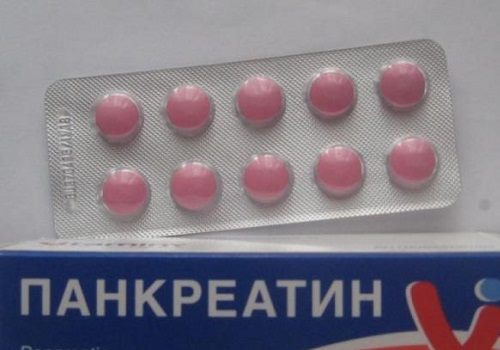
For people of the Muslim faith, it is impossible to find a drug that has no connection with pork. The annotation does not indicate the exact origin of the raw materials. In terms of the composition of enzymes, the pig is closest to humans, therefore extracts of its organs are used to produce medicines.
Forms of release of the drug
Pancreatin is available in pharmacies in the form of tablets and dragees. Capsular preparations have a different name, although they also contain pancreatin. The surface of Pancreatin tablets is covered with a protective coating that prevents the contents of hydrochloric acid from being affected by gastric juice. Therefore, they are classified as gastroresistant. Pharmacologists can tell you the differences between dragees and tablets:
- the tablet is obtained by compressing the powder, looks flattened, then coated with an acid-resistant layer,
- dragees - have a spherical shape, the active ingredients are applied in layers, the additional components necessarily include sugar syrup.
Pancreatin in tablets is made by the Serbian company Galenika ad
The tablets are colored pinkish-brown, the dragees are bright crimson, and children's Pancreatin is green.
The mention of “pills” and the powder version of the drug should be left in the distant past. To this day, the network offers to buy pancreatin powder from the warehouse in bags by weight from 4.5 to 10 kg. The raw material has a grayish color, fine-grained structure, and a characteristic odor. But it is almost impossible to find a pharmacy that will do the hanging and make dosed sachets of 1.0 g. A special license is required for this.
It is completely impractical to engage in outdated production in the presence of a variety of cheap forms of Pancreatin.
Composition and beneficial properties
In composition, different types of Pancreatin differ in the number of enzymes and auxiliary chemicals. In international pharmacology, enzymes are usually evaluated in units of activity. For pancreatic juice, lipase is most sensitive. Therefore, Pancreatin packages indicate the name of the drug and a number indicating lipolytic strength.
Other enzymes are added in the ratio that exists in a healthy body:
- lipase - necessary for converting dietary fats into bile acids, which serve as emulsifiers during digestion,
- amylase - converts carbohydrates and starch into simple sugars, which are easily digested and sent to the liver for energy production,
- proteases - are involved in the hydrolysis of proteins, consist of various enzymes, trypsin and chymotrypsin are of particular value for digestion, they bring the breakdown of complex proteins to essential amino acids.
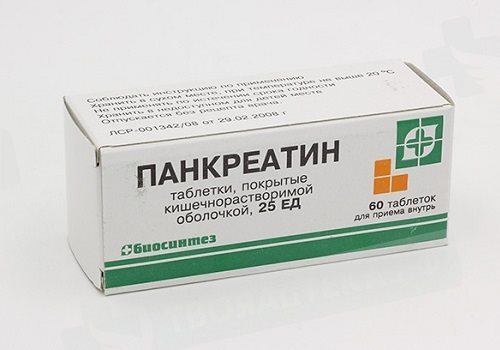
A description of the general properties of a natural pancreatic juice substitute is as follows:
- “extracting” energy from carbohydrates,
- providing cells with the necessary plastic materials for renewal, creation of immunity,
- supply of coenzymes for the synthesis of complex biochemical substances, vitamins,
- “feeding” beneficial bacterial flora.
These functions are violated:
- for diseases of the pancreas (acute and chronic pancreatitis, cystic degeneration, tumor),
- when used in the treatment of a surgical method of removal or partial resection of the gland, stomach or intestines,
- with a reactive inflammatory process with suppression of the production of pancreatic enzymes in diseases and functional overload of other organs.
Tablets and dragees differ in the method of recording the active substance. It is indicated in the annotation in mg or international units of activity.
The mass can be found in tablets of 100, 125, 250, 300 mg, in Pancreatin forte - 192 mg. Lipolytic activity varies depending on the type of tablet: 25, 30, 8000 units. For doctors, the best option is a drug with the specified enzyme activity. It is convenient in selecting the dosage and comparing it with analogues from different companies.
Each type of Pancreatin includes its own amount of enzymes. The minimum activity in the drug is considered to be:
- lipase - 4.3 thousand units,
- amylase - 3.5 thousand units,
- proteases - 200 or more units.
There may be differences in additional substances, but the required components are:
- talc - added to the powder to improve the structure, into the shell for easier sliding through the esophagus,
- Magnesium stearate - quickly crushes (emulsifies) components, mixes with food,
- polyvidone - promotes the formation of water-soluble complexes and improves the absorption of formed nutrients in the intestine,
- dyes - responsible for design and appearance.
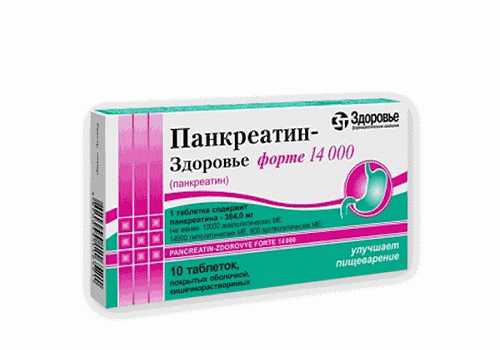
To achieve the expected effect, you should take the drug correctly, taking into account its mechanism of action. There is only one way to take the medicine - swallow the tablet or pill without chewing it in your mouth. The enteric coating disappears only in the duodenum, where the reaction of the environment approaches alkaline. Enzymes are mixed with food and begin to act.
Please pay attention! Do not take the drug on an empty stomach. In the absence of a bolus of food, enzymes direct their breaking down abilities to the mucous membrane. With a peptic ulcer, this can lead to bleeding, which is expressed by black, loose stools.
The released enzymes actively stimulate the secretion of other organs (stomach, small intestine, liver) and improve the secretion of bile. The maximum surge in activity is recorded 30-40 minutes after use.
How to restore pancreas function with diet
Repeatedly, victims are interested in whether it is possible to resume the work of a diseased organ, how to treat the pancreas in diabetes mellitus, how to lower the glucose ratio.
To recover, take medications and eat healthy foods that help the pancreas regenerate. The recovery period for illness is long, therefore it is necessary to adhere to the rules of nutrition for pancreatitis in order to improve the functioning of the organ, adhere to the proportions of consumption of fats, proteins and carbohydrates.
- It is allowed to consume carbohydrates in the amount of 300 g, proteins 100 g. and fats 60 grams.
- You need to eat food often 5-6 times throughout the day, in small portions.
- Diabetic patients should eat boiled, steamed food.
- Avoid fried foods completely.
- Stew, bake, perhaps during remission.
- It is prohibited to season dishes with those spices that lead to a stimulating effect on the intestinal mucosa.
- If there is an exacerbation of the pathology and during therapy, it is unacceptable to eat fatty, spicy, smoked foods, and baked goods.
Before treating a disease, you should consult a doctor, as complications of the disease are possible.
What does Pancreatin help with: indications for use
Pancreatin, as a substitute for its own enzymes, is indicated for patients with diseases and conditions caused by insufficient functional production of the pancreas. Exocrine disorders cause signs of digestive disorders and a predisposition to the inflammatory process. On the other hand, the presence of pathology in the liver, stomach, intestines, and gall bladder suppresses the synthesis of pancreatic juice.
Pancreatin is prescribed by doctors for therapeutic purposes for the following diseases:
- chronic pancreatitis,
- cystic changes in the gland in patients with cystic fibrosis,
- gastritis and peptic ulcer,
- cholecystitis,
- liver diseases,
- biliary dyskinesia,
- in the postoperative period, when part of the stomach and intestines is removed (Crohn's disease),
- in cases of compression of the ducts that carry contents into the duodenum, tumor, tissue edema after radiation therapy,
- development of autoimmune pancreatitis after organ transplantation,
- signs of enzyme deficiency in old age and in patients with type 2 diabetes mellitus, when fibrosis affects the glandular endocrine areas,
- forced immobility of patients (paralysis, paresis, fractures, obesity),
- consequences of cholecystectomy,
- failure to digest food caused by the inability to chew, dental problems, jaw fracture,
- unclear dyspeptic syndrome.
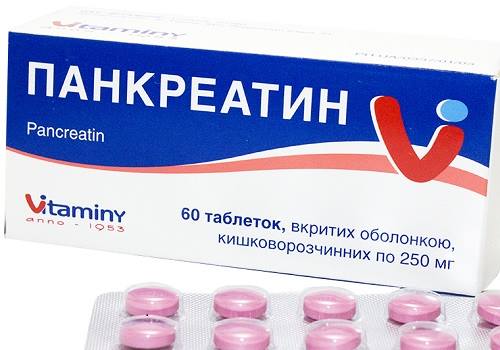
The body needs help if the breakdown is caused by overeating after fasting or on holidays, consuming a significant amount of fatty and fried foods that are difficult to digest, or a violation of the diet by diabetics.
Symptoms of disorder in the digestive system can be associated with the thoughtless use of fasting diets, significant breaks in nutrition, pregnancy, and stress. Children have to be treated for intestinal disorders caused by uncontrolled consumption of carbonated water, chips, fast food, when the baby is allowed to eat “adult” food.
Pancreatin can be used to cleanse the intestines of gases and normalize stools before ultrasound and x-ray examinations.
Clinical manifestations of enzyme deficiency are:
- dyspeptic syndrome (nausea, liquid stool with a greasy sheen, bloating),
- pain in the upper abdomen on the right, girdling in nature,
- heartburn and bitter belching,
- complaints from older people that “the chair either strengthens or weakens.”
You should not rely on a drug to combat obesity. The lipolytic enzyme transforms dietary fats into fatty acids, but does not remove endogenous and subcutaneous fat deposits. The drug helps restore metabolism. Perhaps if excess weight is associated with impaired absorption of fats, then the benefit will appear. However, using large doses without indications is strictly prohibited. A person will not stop getting fat, but will acquire additional dangerous problems caused by an overdose. You cannot treat yourself with Pancreatin.
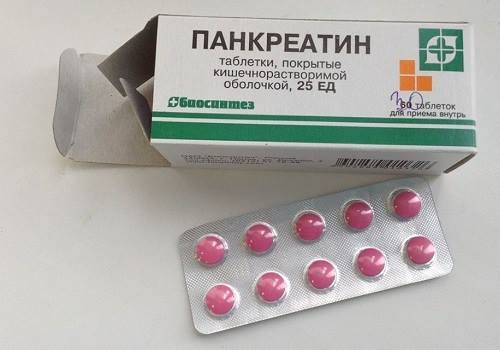
In order to prevent exacerbation of chronic pancreatitis, patients during the period of remission receive a maintenance dose prescribed by the doctor. The theory of “pancreatic habituation” is not recognized by most gastroenterologists. Studies show the advisability of using enzyme preparations for compensation if the disease progresses and gradually affects a significant part of the organ.
Where is the connection between them?
If diabetes mellitus (DM) develops, changes in structure and functional activity form in the pancreas. Dystrophic damage to the islets of Langerhans occurs, which entails a decrease in the number of endocrine cells or their death. Next, the pancreatic type of disease develops, when dysfunction of only the endocrine apparatus is observed, or total, when the organ completely stops its work. This is caused by the replacement of structures with connective tissue, which compresses healthy cells and provokes degenerative changes in them.
Basic regimens and dosages
Pancreatin in any form is taken only when there is food in the stomach (during meals, immediately after). The drug should be swallowed whole; the tablet should not be chewed or crushed. To wash it down, half a glass of water or non-alkaline mineral water without gas is enough. Children are allowed to use tea and juice.
The dosage is selected by the doctor based on the clinical course of the disease, test results, and the patient’s age. The calculation is carried out in units, then the entire amount is divided into main meals (usually 3-4, but in case of chronic diseases it is possible more often, since fractional meals are indicated).
The daily amount of enzymes taken by an adult should not be higher than 15-20 thousand units. per kg body weight. For chronic pancreatitis, 2-4 tablets are prescribed per dose. If digestive breakdown is caused by overeating, then 1-2 tablets are enough. The sufficiency of the dose is determined by the elimination of signs of dyspepsia and pain. Correction is possible both in the direction of increase and gradual withdrawal of the drug after normalization of stool and well-being.
Regarding the prescription of Pancreatin to children, the official instructions indicate the possibility of safe use only after 6 years. Permitted dose:
- 6 years - 1 tablet per day,
- 8 years - 1-2 tablets or dragees,
- from 10 years - 2 tablets per day.
What is the need for a particular child is determined by the doctor, taking into account the recommendations of various manufacturers. For example, Pancreatin 8000 is generally not suitable for treating children; the instructions say that the drug has not been sufficiently tested in this age group.
The maximum dosages are used by patients with cystic fibrosis. For them, the daily requirement is 10 thousand units. (by lipase) per kg of body weight. It is more convenient to take drugs with high dosages of pancreatin (Creon 10000, 20000, 40000).
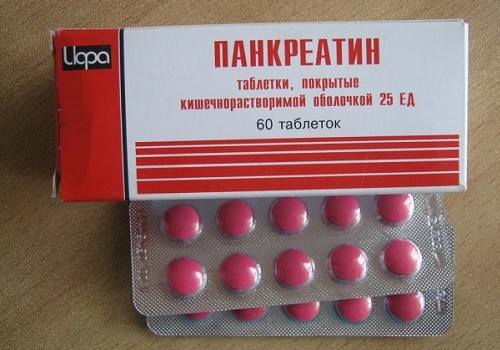
The duration of treatment for diet disorders and overeating is several days. To restore digestion during gastritis, peptic ulcers, cholecystitis, Pancreatin is prescribed for 1-3 months. In chronic pancreatitis, replacement therapy is carried out throughout life.
For gastrointestinal diseases
Reactive dysfunction of the pancreas accompanies inflammatory diseases of the stomach and intestines. The doctor judges the presence of organ failure based on tests and clinical symptoms and does not prescribe Pancreatin to all patients.
Excess enzymes can cause harm in the acute stage of the disease, because they stimulate hypersecretion of gastric and intestinal juice. Therefore, if necessary, the drug is used at the recovery stage, 1 tablet 3-4 times. This helps to expand the diet and switch to normal nutrition.
Pancreatin for diabetes
Diabetic patients need the drug if the disease is caused by primary pancreatitis or its connection to a violation of insulin synthesis by the endocrine part of the gland. The appointment is controlled by an endocrinologist. Forms of the drug without sugars are selected (dragées are not suitable). Low doses are sufficient - 1 tablet three times a day. Control tests include blood amylase and urine diastase.
For gallbladder diseases
Cholecystitis rarely occurs in isolation (without inflammation in neighboring organs). The gallbladder and the outflow tract into the duodenum are united with the pancreas by a common outlet and the work of the sphincter of Oddi at the exit border. Anatomical proximity made it possible to isolate the problem into the “common channel theory.”
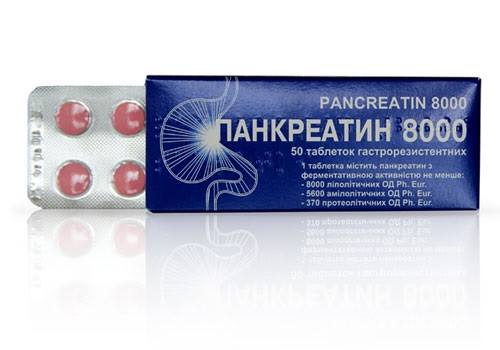
When pancreatitis or cholecystitis spreads, it necessarily involves part of the excretory tract. A similar process accompanies the formation of salt concretions, which later turn into stones. Increasing secretion by adding enzyme activity causes the stones to move. This causes attacks of cholelithiasis (GSD), “hammers” and clogs small ducts. Stagnation promotes self-digestion of tissue.
Therefore, Pancreatin is contraindicated in the presence of stones, in the acute stage of the disease. To be sure of the choice, the patient must undergo an ultrasound examination. The drug is prescribed in the postoperative period following cholecystectomy. In this case, the absence of a bladder needs to stimulate the transport of bile through the ducts.
Pancreatin for the liver
Liver damage is caused by inflammation (viral and bacterial hepatitis), alcohol disease, fatty degeneration, tumors, and cystic changes. In patients with chronic diseases, liver function can be damaged by long-term use of drugs (anti-tuberculosis drugs, Paracetamol, Methyldopa, Nifedipine, Azathioprine, Amiodarone, tetracycline antibiotics, Clarithromycin, Ibuprofen, hormonal drugs, Indomethacin), contraceptives, poisoning.
If there is pathology of the organ, the need to use Pancreatin may be indicated by signs of involvement of the pancreas; the drug will not be able to cure the underlying disease.
Enzyme preparation is contraindicated:
- in the acute stage of hepatitis,
- with established liver failure,
- if the intrahepatic bile ducts are blocked or compressed by a cyst, tumor,
- when, based on biochemical blood tests, there is a suspicion of organ dysfunction.
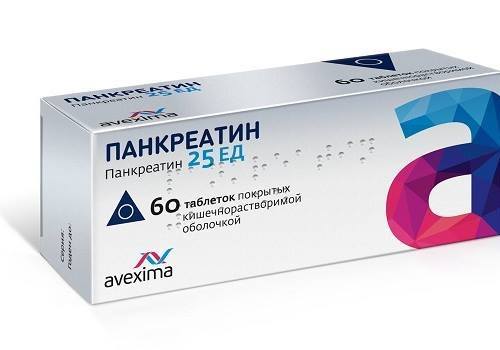
Markers of damage to liver cells are considered to be the growth of enzymes: alanine and aspartic transaminases, lactate dehydrogenase, glutamyl transpeptidase, cholinesterase, arginase, bilirubin in the blood plasma.
Chronic pancreatitis in type 2 diabetes mellitus treatment
Chronic pancreatitis is an inflammatory phenomenon, the development of which occurs in the pancreas, leading to irreversible transformations in cells and tissues. In cases of severe disease, a significant part of the pancreatic tissue is replaced.
In this case, the glandular tissue degenerates into connective and fatty tissue. Internal and external secretion is disrupted in the organ. At the level of external secretory deficiency, the development of enzymatic deficiency occurs, and at the level of internal secretory deficiency, impaired glucose tolerance and, as a consequence, diabetes mellitus.
This type is called pancreatogenic, that is, formed against the background of inflammation of the pancreas. It is chronic pancreatitis that causes diabetes mellitus (DM), in other words.
Diabetes, of course, can occur as an independent disease, so that patients with type 1 or 2 diabetes may develop classic pancreatitis. In this case, pancreatitis is considered the underlying disease.
Characteristics of the drug
Pancreatin is a digestive enzyme designed to compensate for the insufficiency of the exocrine function of the pancreas.
The main active ingredient is pancreatin, which includes enzymes - lipase, proteinase, amylase. Thanks to these components, proteins, triglycerides and starch are broken down.
According to the instructions for the drug, the medicine is indicated for chronic pancreatitis, which allows Pancreatin to be taken in diabetes complicated by this disease.
Increased beta cells
It is possible to solve the problem of decreased spring secretion of the pancreas in diabetes by increasing the number of beta cells, whose function is to produce insulin. For this purpose, they clone their own cells, after which they are implanted into the gland. Thanks to these manipulations, the functions lost by the organ are completely restored and the metabolic processes carried out in it are improved.
Thanks to special protein preparations, supportive assistance is provided during the transition of transplanted cells, which are essentially only transplantation material, into full-fledged mature beta cells capable of producing insulin in sufficient quantities. These medications also increase the production of insulin by the body's remaining intact beta cells.
Rationale for use
Diabetes mellitus and chronic pancreatitis are interrelated.
With the loss of exocrine pancreatic function, exocrine insufficiency occurs (enzyme production decreases), which can cause a complication - pancreatogenic diabetes mellitus.
The chronic inflammatory process in pancreatitis leads not only to exocrine insufficiency, but also to the destruction of the islets of Langerans. Exocrine pancreatic insufficiency is especially common in type 2 diabetes mellitus.
Pancreatogenic diabetes is characterized by the following symptoms:
- dyspeptic symptoms;
- pain in the epigastric area;
- increased blood glucose levels;
- skin diseases;
- frequent infections.
The combination of diabetes mellitus and chronic pancreatitis requires a special approach to treatment tactics.
Treatment methods
Due to the fact that the development of diabetes depends on the presence of chronic pancreatitis in the patient, treatment of the disease consists of eliminating the main cause - pancreatitis.
The basis of therapy is a strict diet and adherence to a diet . Drug treatment is complex and involves the use of enzyme preparations. It is recommended to take Pancreatin for type 2 diabetes.
Treatment of pancreatogenic diabetes requires compensation for exocrine pancreatic insufficiency, which can be achieved by using Pancreatin or its analogues: Festal, Mezim, Creon.
The effect of Pancreatin on diabetes mellitus
The administration of enzymes for diabetes mellitus helps:
- improving carbohydrate metabolism;
- stabilization of glycosylated hemoglobin levels;
- increasing glycemic control;
- reducing the risk of developing diabetes complications;
- improving the quality of life of patients and improving their well-being.
According to research by German scientists, Pancreatin therapy for exocrine pancreatic insufficiency in type 2 diabetes can be used together with hypoglycemic agents and does not affect the patient’s glycemic profile. This treatment is considered highly effective and safe.
Medical nutrition
Pancreatitis and diabetes mellitus must be treated comprehensively. In parallel with drug therapy, patients are required to adhere to dietary nutrition. This approach will help avoid complications, achieve stable remission, and improve the quality of life of patients.
Basic principles of nutrition for pancreatitis and digestive disorders
The basic rules of nutrition for pancreatitis are to balance the nutritional value of the foods consumed. It is necessary to increase the amount of protein, reduce the consumption of simple carbohydrates and optimize the number of plant and animal products.
Food containing protein has a beneficial effect on the course of pancreatic diseases. Proteins are found in foods: meat, fish, soybeans, egg whites and nuts. Regardless of the presence of diabetes in the anamnesis, split meals are important.
The regimen involves 6 meals a day in portions weighing no more than 300 g.
For the treatment of aggravated and chronic inflammatory processes of the pancreas, a special diet table No. 5p has been developed. For diabetes, table No. 9 is used.
For patients with pancreatitis, it is important not to provoke strong secretion of gastric juice, as with a stomach ulcer. An increased content of hydrochloric acid causes the production of gastrin. The hormone stimulates the secretion of the pancreas, its digestive enzymes and insulin. It is necessary to exclude spicy and sour foods, fried and smoked foods from the diet. Drinking alcohol is prohibited.
The diet for ulcers, as for pancreatitis, involves steaming or boiling dishes, grinding them and serving them warm. Mechanical stress and temperature changes have an adverse effect on the gastric mucosa, causing inflammation and the production of pancreatic enzymes.
Do's and Don'ts for Pancreatitis and Diabetes
The diet of patients in each case is selected individually, taking into account concomitant pathologies.
The diet for pancreatitis and diabetes mellitus should also take into account taste preferences and intolerance to specific foods and at the same time is designed to compensate for the lack of nutrients.
This deficiency occurs as a result of insufficient absorption of proteins, fats and carbohydrates. The menu should take into account the body's glucose tolerance level.
In case of diabetes, the diet of patients includes a sufficient amount of protein foods. Protein-rich foods break down slowly and do not cause spikes in blood sugar and are recommended for diabetics.
When the chronic inflammatory process worsens, rice, oatmeal and semolina porridges are excluded from the diet. Preference is given to buckwheat. The bread should be chosen gray, and before eating it, it should be dried. Fresh and rich baked goods, especially with gastritis with low acidity, cause rotting of poorly digested food.
This complicates the breakdown of carbohydrates, increases the load on the pancreas and leads to spikes in blood sugar. For mild diabetes and chronic pancreatitis, it is allowed to eat crackers and bagels. These products are relatively low in calories. It is better to soak bagels and dryings in tea.
Such gentle nutrition does not irritate the mucous membrane and enriches the patient’s menu.
In case of severe diabetes, the patient is prohibited from eating sweets and sweet fruits. But with low sugar levels and chronic pancreatitis, you can include a small amount of sweets in your diet.
Vegetables and fruits during exacerbation of diseases must be heat treated. During remission, it is allowed to eat raw. Sour fruits: apples, plums, etc. are contraindicated in the acute phase of the disease.
In addition to the fact that these fruits stimulate the production of gastric and pancreatic juices, plums for pancreatitis increase diarrhea and worsen the course of diseases. During stable remission, you can eat sour fruits in small quantities.
They contain a large amount of fruit acids, vitamins and minerals that have a beneficial effect on the body and its regenerative functions.
It is good for diabetes to drink skim milk and dairy products; they are also allowed for pancreatitis. Thanks to amino acids and enzymes, dairy products are easily digestible, and the presence of protein, calcium and other micro and macroelements helps to subside inflammation and restore body functions.
You also need to reconsider the quality of fats in your diet. The diet for pancreatitis and ulcers prohibits pig lard, beef fat and lamb fat. It is better to give preference to lean meat (chicken, veal) and river fish. Vegetable fats must be present in the diet: olive, flaxseed and others. They have a healing effect on the restoration of cellular structures, normalize cholesterol and fat metabolism.
Patients are prohibited from drinking chocolate and cocoa. Spicy garlic, onions and radishes with pancreatitis cause sharp pain and severe diarrhea, even with stable remission.
special instructions
The use of Pancreatin should be taken seriously, carefully study the instructions and indications. In treatment, the drug is never used alone; a diet, regimen, other medications, and physical procedures are prescribed.
It should be remembered that with a long course the drug exhibits harmful effects:
- absorption of iron in the intestine is delayed,
- Not enough folic acid salts are supplied.
This provokes the development of iron deficiency and B12 deficiency anemia. Therefore, the doctor must monitor hemoglobin and red blood cells in the blood.
Pancreatin should not be taken simultaneously with antacids (calcium carbonate, magnesium hydroxide). They reduce the effect of enzymes. If necessary, take a break of 1.5-2 hours between doses.
Among the forms for children there is a version produced in Ukraine. It is allowed to be prescribed from the age of three. Do not follow advice about crushing tablets into pieces or crushing them into powder. You should consult your pediatrician about the possibility of opening the outer capsule when replacing it with a drug in microgranules. Cases of oral irritation, stomatitis, ulcers, and perianal dermatitis have been reported in children. Allergies are more common in premature babies and those who have suffered a birth injury.
For constipation or diarrhea in pregnant women, the cause is hormonal changes and impaired peristalsis. It makes no sense to prescribe Pancreatin; enzymes do not affect intestinal motility. All manufacturing companies warn in the instructions about insufficient research on the effect of the drug on pregnant women and the fetus.
When purchasing, you should pay attention to whether the drug is expired by the date indicated on the package.
Possible side effects
Side effects from the drug were recorded in less than 1 case per 10,000 uses. Most often they manifest themselves in the form of an allergic reaction to the dyes that make up the tablet. If itchy rashes, swelling of the face, tongue, or nasal congestion appear, then stop using the drug immediately, take an antihistamine (Diphenhydramine, Suprastin, Loratadine), and tell your doctor.
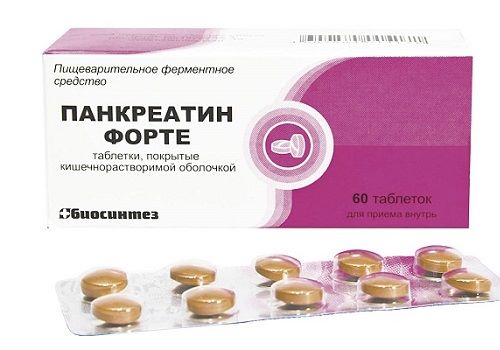
In patients with cystic fibrosis, at high doses, there may be a disturbance in the metabolism of uric acid, an increase in concentration in the blood and urine, the appearance of joint pain, and attacks of urolithiasis.
The rarest complication is the formation of adhesions and strictures in the border zone of the ileocecal region, where the small intestine passes into the ascending colon. It manifests itself as signs of obstruction.
Overdose
Overdose occurs with constant consumption of high doses by patients with cystic fibrosis, or when patients self-medicate. In addition to side effects, exacerbation of diarrhea, pain in the epigastric area, nausea and vomiting are possible.
Contraindications to the use of Pancreatin
The drug is contraindicated for people with the following pathologies:
- acute pancreatitis, exacerbation of chronic,
- hypersensitivity to components, manifested by allergies,
- constipation caused by intestinal obstruction,
- acute form of hepatitis.
Mechanism of development of pancreatic diabetes
Medical experts have not reached a consensus regarding the etiological pathogenesis of the disease as pancreatic diabetes. The development of the “sweet” disease is caused by the gradual destruction and sclerosis of the insular apparatus, which is a response to inflammation in the cells that contribute to the production of digestive enzymes.
The human gland is characterized by the property of mixed secretion. Its function is to produce enzymes that are released into the digestive tract, which helps improve food digestion. The second function is the production of insulin. This is a hormone that regulates blood sugar through its disposal.
The prolonged course of alcoholic or chronic pancreatitis, attacks of exacerbation of the disease lead to the fact that in addition to the gland, which is responsible for the digestive process, the insular apparatus, located in the form of the islets of Langerhans, is affected.
Often the impetus for the development of diabetes mellitus is other disorders occurring in the endocrine system. Symptoms of secondary diabetes resemble the first type of disease, but the difference is that the gland tissue is not affected by autoantibodies.
The following reasons can lead to insulin resistance:
- Itsenko-Cushing's disease.
- Pheochromocytoma.
- Glucagonoma.
- Wilson-Konovalov pathology.
- Hemochromatosis.
Conn's syndrome is accompanied by a disorder of potassium metabolism in the body. Liver hepatocytes are unable to function normally without sufficient potassium to utilize sugar. In this case, diabetic symptoms develop, accompanying a hyperglycemic state.
Complications of chronic pancreatitis - parapancreatitis, pancreatic tumors, somatostatinoma - can lead to the development of diabetes mellitus.
An internal organ can become a target of poisons and toxic substances - pesticides, corticosteroids, etc.


